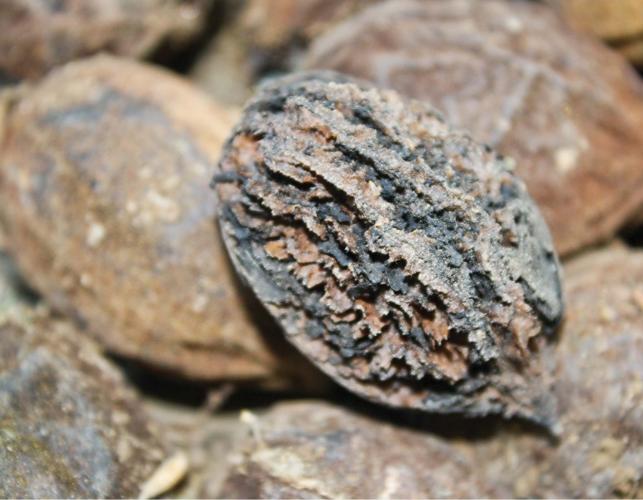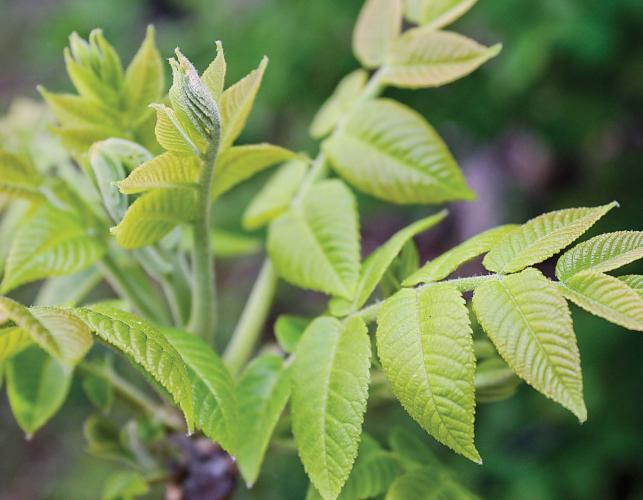The best stories are centered around an impossible task—something everyone thinks can never be achieved— except for one person who refuses to give up. Those stories captivate our imaginations. But you needn’t look for the latest action movie or a best-selling novel to find a story like this.
Missouri’s “Mission Impossible” is to save two different trees with similar plights. The heroes of this tale are ordinary citizens who refuse to accept defeat.
A Tale of Two Trees
Two Missouri tree species are declining toward extinction, but there are some people who have vivid memories of their importance.
“The Ozark chinquapin nuts were delicious and we waited for them to fall like you would wait on a crop of corn to ripen—they were that important,” says 85-yearold Harold Adams of southeast Missouri.
“Up on the hilltop, the nuts were so plentiful that we scooped them up with flat-blade shovels and loaded them into the wagons to be used as livestock feed, to eat for ourselves, and to sell,” Adams says. The trees also benefited local wildlife.
“Deer, bears, turkeys, squirrels, and a variety of other wildlife fattened up on the sweet crop of nuts that fell every year,” he says.
Gerald Angel has similar memories of another tree in Reynolds County.
“I used to collect all the butternuts I wanted back then,” he says. “They were good, too. We cooked butternuts like we did walnuts.”
Memories like these are rare. Although chinquapin and butternut trees made lasting impressions on the minds of many Missourians during the past century, today there aren’t enough of the trees left to continue their legacy without individuals willing to fight to save them.
“Starting in the 1950s and 1960s, all of the trees started dying off,” Adams says. “Now they are all gone and no one has heard of them.”
The Butternut
Butternut lumber was historically used for fine wood products such as furniture, cabinets, wall panels, church altars, and stagecoach interiors. Also known as “white walnut,” the wood was valuable in the 18th and 19th centuries all over the eastern United States, but few modern loggers have even seen a butternut tree.
Butternut is a relative of the black walnut, but it’s easy to work and is much lighter. “The lumber is beautiful,” says Greg Hoss, retired manager of the George O. White Nursery in Licking. “It has the same grain and texture as black walnut, but is a lighter brown color. The wood carves like butter and glues together well.”
Hoss’s family has owned land along Missouri’s Black River in Iron County since the mid 1970s. There, a scattering of butternuts grew in the hills and along the river. Many were 15–20 inches in diameter.
“Some of the trees lasted until the 1990s,” Hoss says. “But on our 30 acres, we don’t have any butternut left, nor do we see any downriver on the neighbor’s property.”
Hoss’ story is identical to many other landowners and one that resounds with carvers who prefer to work with butternut wood. Unfortunately, they soon may not be able to obtain it.
The Ozark Chinquapin
The sweet nuts of the Ozark chinquapin compare to the pecan, but resemble acorns. Instead of a cap, they sport a spiny burr to protect the nuts from early harvest by squirrels and mice. This makes for easy tree identification.
Tino Burnett is a Cherokee tribe member who now resides in Eucha, Okla. When recalling his youth in the Ozarks, he remembers the chinquapin’s burrs as much as the nut’s sweet taste.
“I used to walk the woods with bare feet. My skin was tougher then,” Burnett says. “I’d step on those burrs and boy, did it hurt.”
Although Burnett remembers using rocks to crack the nut out of the burrs, he says it was worth the pursuit. “We’d walk miles to get to a chinquapin tree,” he says.
But the tree’s value goes far beyond just being used as a food source. Chinquapin trees are known for their attractive and rot-resistant lumber, whose uses ranged from fence posts and shingles to fine furniture, dulcimers, and violins. The trees provide food and shelter to wildlife, and Native Americans used the leaves for a cough medicine and the bark as an astringent.
Two Trees, One Tale
Where these two trees’ paths collide is in their demise. Both are succumbing to exotic diseases. Butternuts are dying throughout their range in North America due to a fungus, commonly called the butternut canker, which causes multiple branch and stem cankers that eventually girdle the infected trees, according to MDC Resource Forester Marty Calvert.
Calvert says sprouts that develop from an infected tree are also infected and usually die within a few years. “The canker has been detrimental to butternut trees for roughly 60 years, girdling the trees before they can bear much fruit,” he says.
Succumbing to a different ailment, Ozark chinquapins are maligned by the same Chinese chestnut blight responsible for decimating the American chestnut of the eastern United States. Relation to such a magnificent tree carried an unforeseen price in disease susceptibility for the chinquapin.
Agents of Possibility
A sign of good fortune for both tree species is that in this “Mission Impossible,” there’s more than one hero fighting for success. Landowners, MDC, and a citizen-led, not-forprofit organization have joined forces to save the trees.
Bollinger County resident, Nick Elfrink, is raising butternut trees on his property after picking up nuts in 1987 from butternuts that were next to Trace Creek near Gypsy, Mo. When he moved into his house on the other side of Marble Hill a year later, he planted the nuts on his property. Twenty-five years later, the trees are thriving, with no sign of disease.
“They continue to mature, bloom, and produce nuts every year without much maintenance on my part,” Elfrink says.
Elfrink collects the nuts and plants them near his garden and in his woods. He says that eight or 10 of the trees are growing well. Besides spreading seedlings across his property, Elfrink manages his tree stand by thinning out older red oaks to grant sunlight to the younger trees.
Conservationists hope efforts like these will help existing trees grow and stay healthy long enough to develop a resistance. Although the butternut is the canker’s only host in Missouri, Calvert says a few individual trees, like Elfrink’s, have been found to have little or no signs of canker.
“If seeds can be collected from trees that show no signs of infections, but have come in contact with the disease, then resistant seedlings could be nurtured,” Calvert says.
According to Hoss, the state nursery purchases butternut seed from landowners and seed collectors every year. They mix it and grow as many seeds as they can while continuing to scatter butternut seedlings on Missouri’s conservation areas.
“We’re trying to keep the species alive on the outside chance that resistance is found or the disease disappears,” Hoss explains.
Hoss hopes more landowners will share seeds to meet the demand. Generally, Hoss says the nursery receives only 250 to 500 pounds of seed per year, and sometimes not even that much. Although this yields several thousand seedlings, it’s not nearly the 1,500 pounds of seed the nursery would need in order to provide seedlings for private landowners.
The Ozark Chinquapin Foundation, a group of citizens who are determined to save the chinquapin, hopes to protect their favorite species as well. Their goal is to restore the Ozark chinquapin to its native range and establish a viable chinquapin seed base.
“Through research and cross-pollination of surviving trees, we hope to develop a pure Ozark chinquapin that is blight resistant,” says the group’s president, Steve Bost. He adds that the group will make chinquapin seeds available to anyone who wants to help reestablish the tree to its native range.
You Can Be an Agent, Too
Ultimately, more people must learn to identify and care for the few remaining chinquapin and butternut trees to ensure the survival of these species in Missouri. On private property, landowners can help by identifying butternuts on their property and taking care to preserve them as long as possible, Hoss says.
Landowners should cut out nearby trees that are competing for sunlight, and take care not to damage the tree with lawn mowers or other equipment. Wounds can weaken a tree and allow insects and diseases to access the inner bark, which speeds up the decline process.
“We hope to help the trees live long enough to produce nuts so more seedlings can be planted as the older trees die out,” Hoss says.
By working together, conservationists hope the two trees can go from “Mission Impossible” to “Mission Complete,” making Missouri forests a better place for wildlife and future Missourians.








And More...
This Issue's Staff
Managing Editor - Nichole LeClair Terrill
Art Director - Cliff White
Staff Writer - Bonnie Chasteen
Staff Writer - Jim Low
Photographer - Noppadol Paothong
Photographer - David Stonner
Designer - Stephanie Thurber
Artist - Mark Raithel
Circulation - Laura Scheuler






















